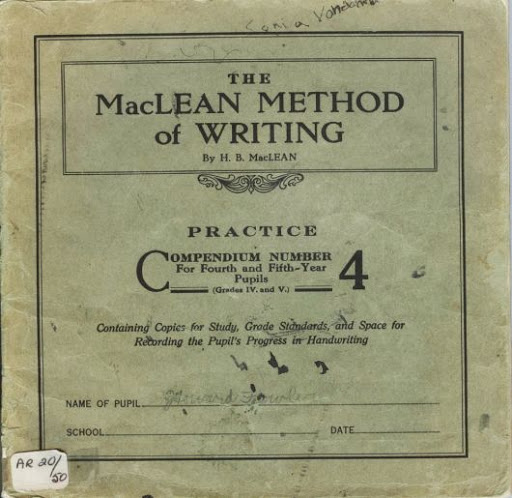Yesterday, we challenged you to decipher the hand-written memoirs of Sarah Ellen Dow. Today, we’d like to introduce (or re-introduce) you to penmanship – that is, the skill of writing effortlessly and flawlessly by hand.
For decades, the leading guide in teaching and learning penmanship was The MacLean Method of Printing and Writing. It was developed in 1921 by H.B. MacLean, a school principal, as a way of addressing teachers’ complaints that they couldn’t read the sloppy handwriting of their students. He devised a “scientific” way of teaching handwriting, starting with fundamentals like how to position the paper and how to sit in the chair, and going all the way up to precise formation of every letter in the cursive alphabet. Students could earn certificates documenting their success every step of the way – at the upper levels, they could even send samples of their penmanship to MacLean himself for grading!
The workbook cover at the top of the page is from one of the more advanced manuals – but, since the MacLean’s method hasn’t been formally taught in schools in many many years now, let’s start with something a little more rudimentary. This lesson is from”My Second Printing Book” for Grade 2:

First, of course, is a review of the basics. Note the positions of the paper and the writer in the pictures above, and be sure you are holding your pencil correctly!
Next come the movement drills – endless repetition of the shapes and strokes and lines of letters. I’d recommend at least a full page of each of these. remember to keep all your shapes and lines uniform and evenly spaced! Your writing should be light and rhythmic – at least according to the instructions at the top of the page:

How are you doing? Hand cramping yet? Ready for the actual letters? MacLean’s compares the printed and cursive forms of each letter, then gives you plenty of opportunities to practice. Line after line after line of practice letters. To reinforce the idea of rhythmic movement, he groups them into letters of similar shape, so, when you’re practicing, don’t go alphabetically. Here’s how he organises them:
- o, a, and c – the “circle” letters (the “technical” descriptions are mine!)
- i, u, e, and w – letters that form a “valley”
- r, s – the letters I can never do properly
- n, m, and v – the “hilly” letters
- l, h, k, b, and f – the “tall loop” letters
- q, g, y, and p – “circle and lower loop” letters
- t and d – tall “stroke” letters.

I notice his practice pages don’t include the letters z or x. Based on the examples given above, where would you put those two in the groupings of letters?
Now for the test. Compare your best handwriting to the sample below, which, according to MacLean, is the standard a seven-year-old child should attain. How do you compare? (My answer: badly. Very badly.) Show us your best sample! Email us a photo (or post it in the comments) and we’ll put it up in our historic schoolhouse where MacLean’s Method was almost certainly taught (or, bring it down to the Museum and pin it up there yourself)! Perhaps you could use it to give us your opinions on this question:
Should penmanship still be taught in school, or is it a skill that technology has made unnecessary?


